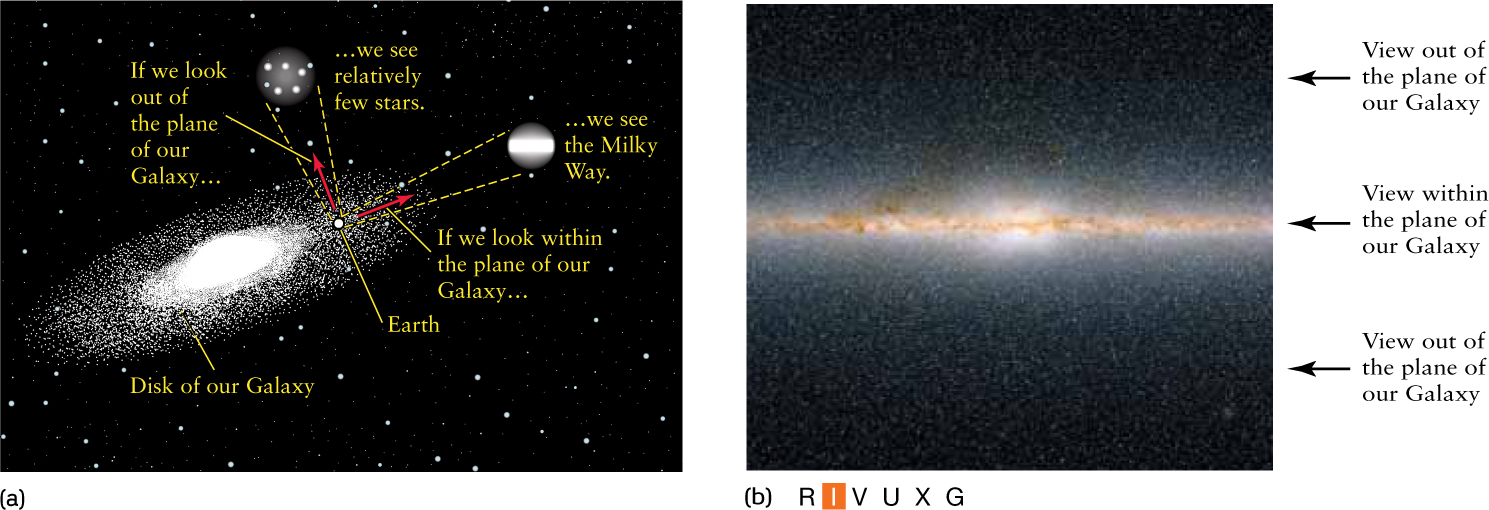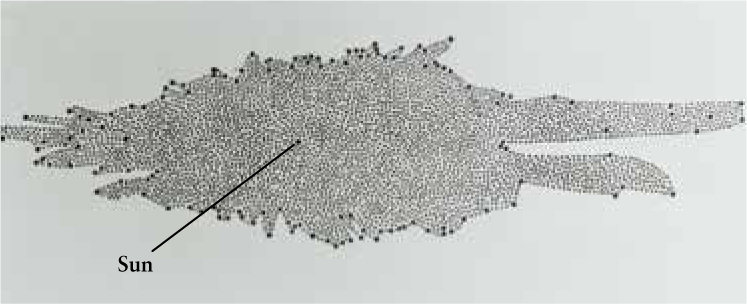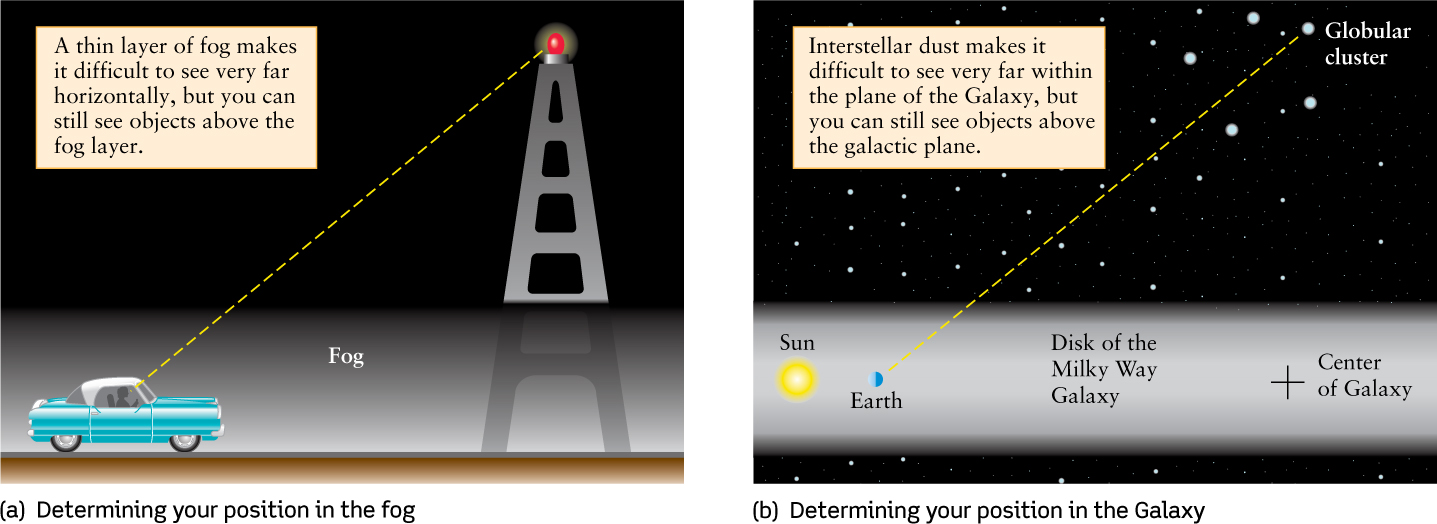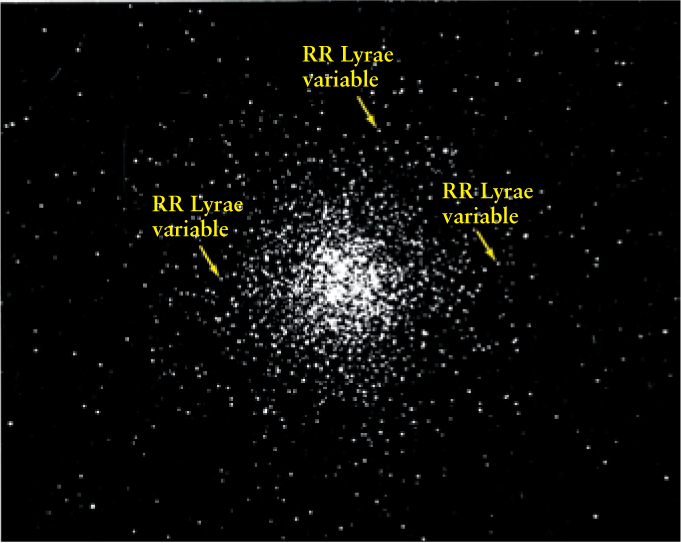22-1 The Sun is located in the disk of our Galaxy, about 8000 parsecs from the galactic center
 Eighteenth-century astronomers were the first to suspect that because the Milky Way completely encircles us, all the stars in the sky are part of an enormous disk of stars—the Milky Way Galaxy. As we learned in Section 1-4, a galaxy is an immense collection of stars—as well as gas and dust referred to as interstellar matter.
Eighteenth-century astronomers were the first to suspect that because the Milky Way completely encircles us, all the stars in the sky are part of an enormous disk of stars—the Milky Way Galaxy. As we learned in Section 1-4, a galaxy is an immense collection of stars—as well as gas and dust referred to as interstellar matter.
Our Galaxy is both large and mostly empty. To put our Galaxy into perspective, consider this scale model suggested by astronomer Mark Whittle: Suppose that our Galaxy was shrunk down to the size of the continental United States. Then, the average distance between the shrunken stars would be about the size of a football field. But what about the stars themselves? The average size of the shrunken stars would be about the size of human cells! Clearly, the stars of the Milky Way are widely separated, and there are a lot of them.
We are within our own Milky Way Galaxy, which makes it hard to view. Our solar system is located inside the pancakelike disk of our Galaxy, which is why the Milky Way appears as a band around the sky (Figure 22-1).

Locating the Sun Within the Galaxy: Early Attempts
But where within this disk is our own Sun? Until the twentieth century, the prevailing opinion was that the Sun and planets lie at the Galaxy’s center. One of the first to come to this conclusion was the eighteenth-century English astronomer William Herschel, who discovered the planet Uranus and was a pioneering cataloger of binary star systems (see Section 17-9). Herschel’s approach to determining the Sun’s position within the Galaxy was to count the number of stars in each of 683 regions of the sky. He reasoned that he should see the greatest number of stars toward the Galaxy’s center and a lesser number toward the Galaxy’s edge.
Herschel found approximately the same density of stars all along the Milky Way. Therefore, he concluded that we are at the center of our Galaxy (Figure 22-2). In the early 1900s, the Dutch astronomer Jacobus Kapteyn came to essentially the same conclusion by analyzing the brightness and proper motions of a large number of stars. According to Kapteyn, the Milky Way is about 17 kpc (17 kiloparsecs = 17,000 parsecs or 55,000 light-years) in diameter, with the Sun near its center.

The Problem: Interstellar Extinction
Both Herschel and Kapteyn were wrong about the Sun being at the center of our Galaxy. The reason for their mistake was discerned in 1930 by Robert J. Trumpler of Lick Observatory. While studying star clusters, Trumpler discovered that the more remote clusters appear unusually dim—more so than would be expected from their distances alone. As a result, Trumpler concluded that interstellar space must not be a perfect vacuum: It must contain dust that absorbs or scatters light from distant stars.
Like the stars themselves, interstellar dust is concentrated in the plane of the Galaxy (see Section 18-2). As a result, it obscures our view within the plane and makes distant objects appear dim, an effect called interstellar extinction. Great patches of interstellar dust are clearly visible in wide-angle photographs such as the ones that open this chapter. Thanks to interstellar extinction, Herschel and Kapteyn were actually seeing only the nearest stars in the Galaxy. Hence, they had no idea of either the enormous size of the Galaxy or of the vast number of stars concentrated around the galactic center.
ANALOGY
Herschel and Kapteyn faced much the same dilemma as a lost motorist on a foggy night. Unable to see more than a city block in any direction, the motorist would have a hard time deciding what part of town he was in. If the fog layer were relatively shallow, however, our motorist would be able to see the lights from tall buildings that extend above the fog, and in that way he could determine his location (Figure 22-3a).

The same principle applies to our Galaxy. While interstellar dust in the plane of our Galaxy hides the sky covered by the Milky Way, we have an almost unobscured view out of the plane (that is, to either side of the Milky Way). To find our location in the Galaxy, we need to locate bright objects that are part of the Galaxy but lie outside its plane in unobscured regions of the sky.
The Breakthrough: Globular Clusters and Variable Stars
Fortunately, bright objects of the sort we need do in fact exist. They are the globular clusters, a class of star clusters associated with the Galaxy but which lie outside its plane (Figure 22-3b). As we saw in Section 19-4, a typical globular cluster is a spherical distribution of roughly 106 stars packed in a volume only a few hundred light-years across (see Figure 19-12).
Observations of pulsating variable stars revealed the immense size of the Milky Way
However, to use globular clusters to determine our location in the Galaxy, we must first determine the distances from Earth to these clusters. (Think again of our lost motorist—glimpsing the lights of a skyscraper through the fog may be useful to the motorist, but only if he can tell how far away the skyscraper is.) Pulsating variable stars in globular clusters provide the distances, giving astronomers the key to the dimensions of our Galaxy.
In 1912, the American astronomer Henrietta Leavitt reported her important discovery of the period-luminosity relation for Cepheid variables. As we saw in Section 19-6, Cepheid variables are pulsating stars that vary periodically in brightness (see Figure 19-18). Leavitt studied numerous Cepheids in the Small Magellanic Cloud (a small galaxy near the Milky Way) and found their periods to be directly related to their average luminosities. Figure 22-4 shows that the longer a Cepheid’s period, the greater its average luminosity.

 R I V U X G
R I V U X GRR Lyrae Variables in a Globular Cluster The arrows point to three RR Lyrae variables in the globular cluster M55, located in the constellation Sagittarius. From the average apparent brightness (as seen in this photograph) and average luminosity (known to be roughly 100 L⊙) of these variable stars, astronomers have deduced that the distance to M55 is 6500 pc (20,000 ly).

The period-luminosity law is an important tool in astronomy because it can be used to determine distances. For example, suppose you find a Cepheid variable in the sky. By measuring its period and using a graph like Figure 22-4, you can determine the star’s average luminosity. Knowing the star’s average luminosity, you can find out how far away the star must be in order to give the observed brightness. (Box 17-2 explains how this is done.)
Shortly after Leavitt’s discovery of the period-luminosity law, Harlow Shapley, a young astronomer at the Mount Wilson Observatory in California, began studying a family of pulsating stars closely related to Cepheid variables called RR Lyrae variables. The light curve of an RR Lyrae variable is similar to that of a Cepheid, but RR Lyrae variables have shorter pulsation periods and lower peak luminosities (see Figure 22-4).
The tremendous importance of RR Lyrae variables is that they are commonly found in globular clusters (Figure 22-5). By using the period-luminosity relationship for these stars, Shapley was able to determine the distances to the 93 globular clusters then known. He found that some of them were more than 100,000 light-years from Earth. The large values of these distances immediately suggested that the Galaxy was much larger than Herschel or Kapteyn had thought.
Another striking property of globular clusters is how they are distributed across the sky. Ordinary stars are rather uniformly spread along the Milky Way. However, the majority of the 93 globular clusters that Shapley studied are located in one-half of the sky, widely scattered around the portion of the Milky Way that is in the constellation Sagittarius.
From the directions to the globular clusters and their distances from us, Shapley mapped out the three-dimensional distribution of these clusters in space. In 1920 he concluded that the globular clusters form a huge spherical distribution centered not on Earth but rather about a point in the Milky Way several kiloparsecs away in the direction of Sagittarius (see Figure 22-3b). This point, reasoned Shapley, must coincide with the center of our Galaxy, because of gravitational forces between the disk of the Galaxy and the “halo” of globular clusters. Therefore, by locating the center of the distribution of globular clusters, Shapley was in effect measuring the location of the galactic center.
Modern-Day Measurements
Since Shapley’s pioneering observations, many astronomers have measured the distance from the Sun to the galactic nucleus, the center of our Galaxy. Shapley’s estimate of this distance was too large by about a factor of 2, because he did not take into account the effects of interstellar extinction (which were not well understood at the time). Today, the generally accepted distance to the galactic nucleus is about 8 kpc (26,000 ly); the actual distance could be greater or less than that value by about 1 kpc (3300 ly).
Just as Copernicus and Galileo showed that Earth was not at the center of the solar system, Shapley and his successors showed that the solar system lies nowhere near the center of the Galaxy. We see that Earth indeed occupies no special position in the universe.
CONCEPT CHECK 22-1
If astronomers observed that globular clusters were evenly spread across all parts of the sky, what would astronomers assume about the location of our Sun and Earth in our Galaxy?
Looking at other galaxies, astronomers have observed that globular clusters tend to form a spherical distribution centered on the center of galaxies. If our own globular clusters appeared in every direction equally, then astronomers would assume that we were near the center of the globular clusters and, subsequently, near the center of our Galaxy.